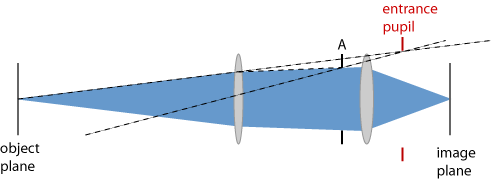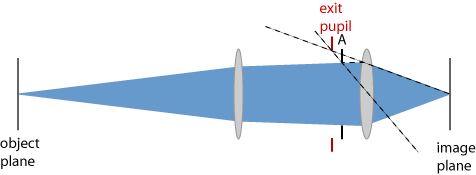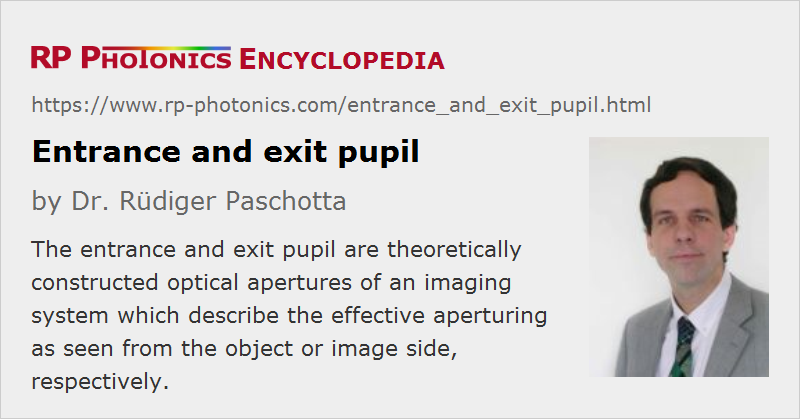Entrance and Exit Pupil
Definition: the apparent apertures of an optical system, seen from the object or image side
German: Eintritts- und Austrittspupille
Categories: general optics, vision, displays and imaging
How to cite the article; suggest additional literature
Author: Dr. Rüdiger Paschotta
An optical imaging system can contain various optical apertures which can limit the passage of light rays. However, not all those apertures may be relevant for the optical performance of the system. Further, the effect of an aperture can be modified by other optical elements. For example, the apparent pupil of a human eye appears larger than the iris opening due to the focusing effect of the cornea. Furthermore, the position of an aperture causing a certain limitation of opening angle also affects the treatment of rays coming from off-axis angular positions.
In order to take into account all those aspects, the abstract concept of entrance and exit pupil has been developed in geometrical optics for describing the effects of optical apertures as seen from outside the system.
Entrance Pupil
We first consider the effects of apertures at multiple positions in the beam path on the opening angle. We assume an imaging system which is focused to some object plane, and we consider rays starting from the center of the object plane. Figure 1 shows that apertures of different diameters at different locations can cause the same limitation of the opening angle. It is important to realize, however, that their effects are not the same for rays starting from a different (off-axis) location in the object plane. Therefore, it is not sufficient to know the maximum opening angle only.

One solves that problem by constructing the so-called entrance pupil, which has a certain diameter and axial position. In Figure 2, this is shown for the system as above, but containing only the middle aperture (A2, now called A). That aperture is imaged to the left side, i.e., considering only the optical elements left of it. The rays on the object side can then be protected back to find the edge of the entrance pupil – in this case a virtual image well behind the first and even second optical surface. The entrance pupil is the apparent aperture as seen from the object side.

With the knowledge of the entrance pupil, one can not only determine the maximum opening angle, but also correctly describe the limitations for rays emerging from other points in the object plane.
For an aperture in front of other optical elements, such as A1 in Figure 1, the entrance pupil is identical with that physical aperture. The construction of the entrance pupil for aperture A3 in Figure 1 would again lead to a different result. Indeed, those three apertures would also have different optical effects on the system performance.
In case of a single thin lens of limited size, and no additional apertures, the entrance pupil would simply be the transparent part of the lens. For a multi-lens system, the entrance aperture can be located before, within or after the optical setup.
For any photographic objective, for example, one can construct the position and diameter of the entrance pupil based on the optical design. In case of multiple apertures, the one causing the strongest limitation of light rays is considered. One can then specify those entrance pupil parameters instead of all the details of actual physical apertures and other optical elements; with those data only, the aperturing effects for the object side are sufficiently specified.
For a zoom lens, the entrance pupil generally depends on the zoom setting.
The opening of a photographic objective is usually specified with the f-number, which is defined as the ratio of focal length and diameter of the entrance pupil.
The axial location of the entrance pupil is also relevant as the camera's center of perspective.
For an objective which is telecentric with respect to object space, the entrance pupil lies at infinite distance from the objective. That leads to an orthographic view, i.e., with a magnification which is independent of the object distance.
For a microscope objective, the entrance pupil together with the focal length is directly related to the numerical aperture, which is the usual specification.
Some authors use the term entrance pupil for what should actually be called the diameter of the entrance pupil; note that the axial position of the entrance pupil is also an important parameter.
Exit Pupil
In an analogous way, we can construct the exit pupil of an optical system, this time imaging the relevant aperture to the right side, i.e., towards the image plane. In our example case (Figure 3), this again leads to a virtual image. That image is again in a conjugate plane of the physical aperture, when considering only the optics after that aperture. Also, one can see that the entrance and exit pupils lie in conjugate planes with respect to the complete optical system.

Depending on the system design, the exit pupil may be identical to a physical aperture on the side of the image plane, or some virtual image which may occur at any axial location. Frequently, it lies behind the optical system.
Ocular lenses of telescopes and microscopes are normally designed such that their exit pupil coincides with the pupil of the observing eye. (Note that the assumed pupil diameter is assumed to be significantly larger for an astronomical telescope than for a microscope, because the viewing conditions are usually relatively dark, leading to a wide pupil.) If the exit pupil were larger, not all exiting light could be utilized by the eye; one would lose image brightness. (That could happen in a telescope, for example, when using an ocular lens with too low magnification, i.e., with a too long focal length, or when using night vision glasses at day time.) A smaller exit pupil of the optical system is also not desirable; it would not allow one to make use of the full angular resolution of the eye. An axial position of the exit pupil away from the pupil of the observing eye would also not be desirable, since the transmission should work for a range of observing directions, and not only for objects in the center of the field of view. The distance between the exit pupil and the last optical surface (or the geometrical end of the ocular lens) is called the eye relief; it can be inconveniently small for some ocular lenses with a short focal length.
The axial position of the exit pupil is also relevant in photography. The closer it is to the image plane, the larger are the angles of incidence on the image sensor at its extreme edges. The objective design should avoid that condition, and possibly even be image-space telecentric, particularly for image sensors with microlenses, which imply a reduced acceptance angle of the detectors.
Questions and Comments from Users
Here you can submit questions and comments. As far as they get accepted by the author, they will appear above this paragraph together with the author’s answer. The author will decide on acceptance based on certain criteria. Essentially, the issue must be of sufficiently broad interest.
Please do not enter personal data here; we would otherwise delete it soon. (See also our privacy declaration.) If you wish to receive personal feedback or consultancy from the author, please contact him e.g. via e-mail.
By submitting the information, you give your consent to the potential publication of your inputs on our website according to our rules. (If you later retract your consent, we will delete those inputs.) As your inputs are first reviewed by the author, they may be published with some delay.
See also: optical apertures, imaging, imaging with a lens, objectives, ocular lenses
and other articles in the categories general optics, vision, displays and imaging
 |






If you like this page, please share the link with your friends and colleagues, e.g. via social media:
These sharing buttons are implemented in a privacy-friendly way!